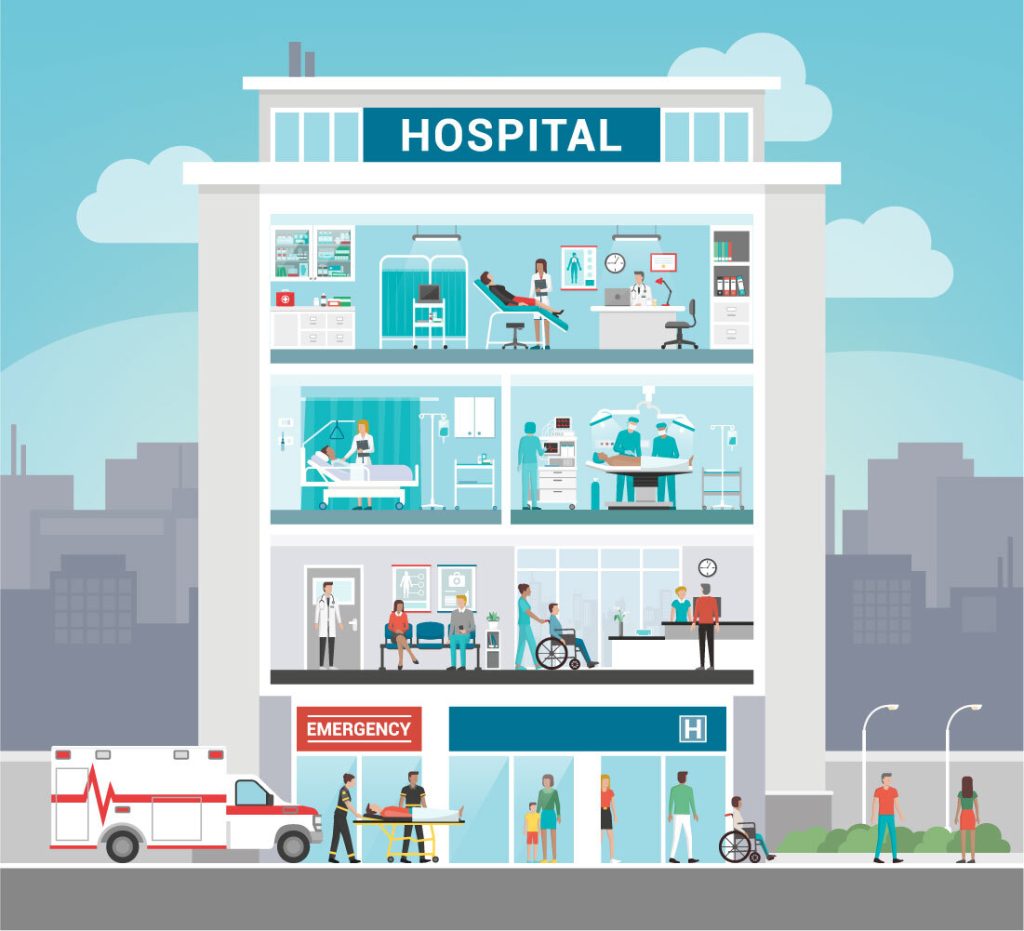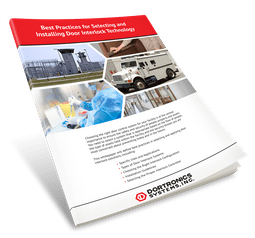Hospitals and healthcare facilities have unique security challenges. From maintaining 24/7 operations to safeguarding valuable equipment and controlled substances, controlling access to various areas within healthcare facilities is of critical importance. The safety of visitors, staff, and patients is also a core security imperative, all while complying with stringent healthcare privacy and security regulations.
To address these challenges effectively, hospitals and healthcare facilities require robust door and access control solutions that ensure only authorized personnel can access designated areas. Such solutions play a pivotal role in protecting sensitive areas within a healthcare facility, preventing unauthorized access and potential security breaches.
But preventing unauthorized access in a healthcare environment is just the tip of the iceberg. That is why smart door control solutions, including door interlock systems, electromagnetic locks, pull stations, and touch-free controls, are deployed to accommodate the unique security requirements of each and every area within hospitals and healthcare facilities.
We invite you to tour the interactive Dortronics Medical Campus to see how our comprehensive range of door control solutions caters to the diverse needs of hospitals and healthcare facilities.
Just hover over and click the desired area for more information.
Emergency Rooms
In a busy hospital emergency room setting, the seamless integration of door control solutions can significantly enhance efficiency and security. For example, electromagnetic locks, also known as maglocks, are ideal for emergency rooms as they facilitate reliable access control functions. These locks can be activated or deactivated remotely, allowing medical staff to swiftly secure or open doors as needed to ensure smooth patient flow while maintaining safety. All Dortronics electromagnetic locks are failsafe, releasing instantly upon command or loss of power for complete regulatory compliance.
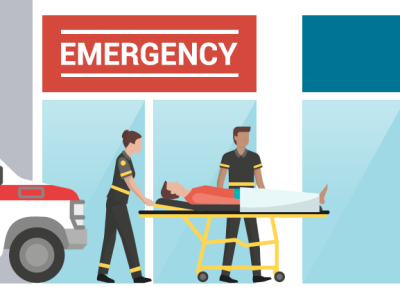 Complementary push buttons are similarly ideal for emergency rooms due to the variety of functions they offer. A simple push button can enable swift door access for individuals in wheelchairs or are otherwise immobile. Push buttons can also be used in scenarios that necessitate a direct request to enter or exit an emergency environment. Panic buttons and keyed emergency lockdown buttons further enhance crisis preparedness in emergency units where violence is not uncommon.
Complementary push buttons are similarly ideal for emergency rooms due to the variety of functions they offer. A simple push button can enable swift door access for individuals in wheelchairs or are otherwise immobile. Push buttons can also be used in scenarios that necessitate a direct request to enter or exit an emergency environment. Panic buttons and keyed emergency lockdown buttons further enhance crisis preparedness in emergency units where violence is not uncommon.
Touchless door control solutions take safety to the next level by providing completely hands-free access to designated areas such as emergency rooms, operating and recovery areas, and more. With the use of motion sensors or a simple wave of the hand, doors can be automatically opened, making it easy for both staff and patients to move within designated areas without touching any handles or buttons. This touchless feature minimizes the spread of germs and enhances infection control measures in hospitals and healthcare facilities.
Patient Rooms
The rise in both patient-facing and staff-facing violence has necessitated strict access control and emergency protocols in patient rooms. Here, emergency push buttons, such as panic buttons and lockdown buttons, are utilized to initiate swift reactionary measures in emergency situations such as an active shooter or aggressive patient behavior. Push buttons can also be utilized in patient rooms to request medical care or bathroom assistance. Dortronics excels at creating custom solutions for a variety of patient rooms’ needs with design options ranging from waterproof, LED illumination, custom engraving, and more. 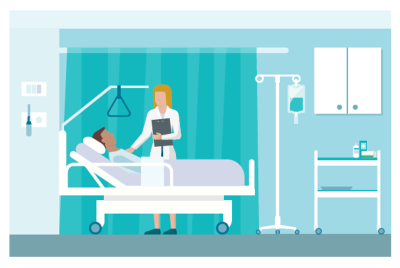
Shared patient bathrooms also necessitate unique door control solutions. In these environments, a two-door interlock controller ensures that only one door can be open at a time, preventing unwanted access to the bathroom while another person is inside. This feature helps maintain patient privacy and hospital security, particularly in cases where multiple patient rooms utilize a common restroom. Interior “privacy” push buttons are illuminated to show that the privacy function has been activated and that the doors are locked.
Emergency access to the bathroom by key is also possible when using manual locksets. This setup not only enhances safety but also promotes a sense of security and comfort for patients in shared facilities.
Visitor Areas
In hospital visitor areas, the strategic implementation of touchless door control solutions significantly contributes to promoting visitor and patient safety. Visitor areas are the one place where guests can come and go as they please, making touchless door control solutions ideal for unrestricted, touchless access control for healthcare. Motion sensors or proximity technology enable hands-free access, allowing visitors to move freely through hospital spaces without touching any surfaces, further reducing the spread of infections and enhancing overall hygiene standards.  These innovative solutions prioritize the safety and well-being of visitors, staff, and patients, fostering a secure and comfortable environment within the hospital premises.
These innovative solutions prioritize the safety and well-being of visitors, staff, and patients, fostering a secure and comfortable environment within the hospital premises.
To protect against improper visitor access, delayed egress solutions prove to be instrumental. This is especially the case when it comes to the protection of newborns, as almost half of newborn (birth to 6 months) abductions by non-family members occur at healthcare facilities, according to documentation by the FBI. With a delayed egress system, an irreversible alarm sounds and a timed countdown begins as soon as someone attempts to operate an exit device or push open a door equipped with a delayed egress locking mechanism. In this way, when unauthorized individuals attempt to leave, they activate an alarm and are delayed from leaving either 15 or 30 seconds before the door can be opened. In this way, those without the proper permissions are impeded or slowed if unauthorized attempts to exit secured areas are made.
Operating Room Areas
In hospital operating rooms, touchless door control solutions play a pivotal role in improving patient outcomes. Touchless access control enables hands-free entry and exit to an operating room, minimizing physical contact and reducing the risk of contamination. This feature is especially crucial in sterile environments where maintaining a clean and germ-free space is paramount to prevent post-surgical infections.
Additionally, heavy-duty and waterproof buttons offer reliable and durable access controls so that medical staff can operate doors without compromising hygiene standards. These buttons can be easily washed down with disinfectants and water without fear of malfunction, ensuring a high level of cleanliness and preventing the accumulation of potentially harmful pathogens. 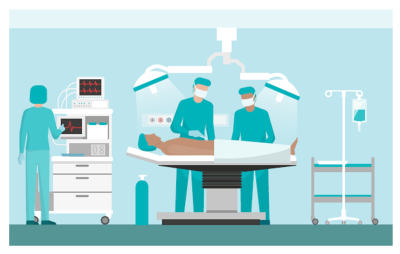
In an operating room, large emergency push plate buttons from Dortronics can serve a dual purpose as kick plates, further enhancing safety protocols. These buttons are designed to facilitate quick and easy door access during urgent situations. Medical staff can activate the emergency push buttons with a simple kick or nudge, allowing for swift entry or exit from the operating room without the need to use hands, which may be occupied or contaminated. The large emergency push buttons’ dual functionality as both a push operated button and kick plate exemplifies their versatility and importance in operating scenarios, where every second counts in ensuring the success of critical medical procedures.
It is worth noting that Mini-Mites, or compact maglocks, offer an effective solution for securing operating room assets when not in use. Mini-Mites installed on all internal cabinets and storage areas could effectively safeguard stored medical supplies and medications all at once. In this way, a patient and/or non-medical staff awaiting the arrival of a medical professional(s) could not access the materials stored within without the proper authorization. With a single swipe of an access card or other secure credential, all materials would become instantly accessible to those who need it.
Diagnostic Equipment Areas
MRIs, X-Rays, CT scans, and other diagnostics are traditionally performed in protected areas within hospitals and healthcare facilities. Not only are the machines that perform these diagnostics costly, but they are also dangerous if used or accessed improperly. Therefore, access to these areas by those not properly trained or during use by another patient can pose a significant health risk to the individual and a liability risk to the hospital.
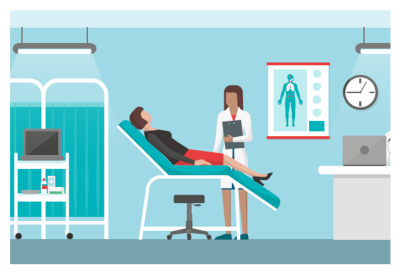 Door interlock solutions from Dortronics create a controlled and secure entry system, allowing only those authorized to enter the room. The interlock system ensures that one door remains locked while the other is open, preventing any unauthorized or accidental entries. This interlocking mechanism effectively restricts access to X-ray and MRI testing rooms wherein a medical professional would need to leave the room before activating the equipment due to the nature of the equipment being used. In these cases, a door interlock system would prevent unauthorized or ill-timed entry.
Door interlock solutions from Dortronics create a controlled and secure entry system, allowing only those authorized to enter the room. The interlock system ensures that one door remains locked while the other is open, preventing any unauthorized or accidental entries. This interlocking mechanism effectively restricts access to X-ray and MRI testing rooms wherein a medical professional would need to leave the room before activating the equipment due to the nature of the equipment being used. In these cases, a door interlock system would prevent unauthorized or ill-timed entry.
Maglocks also provide robust access control functionality within critical diagnostic areas. These locks are designed to securely hold doors shut and can only be unlocked using authorized access control credentials. By implementing maglocks, hospitals and healthcare facilities can prevent unauthorized access to these sensitive areas, ensuring that only trained and authorized personnel can operate the potentially hazardous diagnostic equipment.
Pharmacy
Many hospitals and healthcare facilities have internal pharmacies and pharmaceutical labs and storage areas which require security. Door interlock solutions offer a sophisticated and reliable means of regulating access to these critical areas, significantly reducing the liability and potential threat to both the hospital and its staff.  The interlock system creates a controlled and secure entry process wherein individuals must pass through multiple doors with separate authorizations before gaining access to the pharmaceutical area. In doing so, hospitals and healthcare facilities create a layered security approach that effectively restricts entry to only authorized personnel with the appropriate credentials or access rights. This layered access control minimizes the risk of unauthorized individuals gaining access to sensitive substances or prescriptions, thereby safeguarding against potential theft, misuse, or mishandling of controlled pharmaceuticals.
The interlock system creates a controlled and secure entry process wherein individuals must pass through multiple doors with separate authorizations before gaining access to the pharmaceutical area. In doing so, hospitals and healthcare facilities create a layered security approach that effectively restricts entry to only authorized personnel with the appropriate credentials or access rights. This layered access control minimizes the risk of unauthorized individuals gaining access to sensitive substances or prescriptions, thereby safeguarding against potential theft, misuse, or mishandling of controlled pharmaceuticals.
Once inside the pharmacy or storage area, compact maglocks, or Mini-Mites, offer a reliable access control solution to protect cabinets and drawers where medications are stored. Creating 300 pounds of direct holding force, a Mini-Mite offers protection for smaller doors, much in the same way that larger maglocks work on standard doors. Mini-Mites are capable of being controlled individually, sequentially, or simultaneously from one or several locations so that access to certain drugs can be limited based on application, type, quantity, and more.
Psychiatric Unit
Some areas within hospitals and healthcare facilities require stricter access control than others. A psychiatric unit within a hospital is one such example. These areas house individuals with mental health conditions or psychiatric disorders, which can be dangerous for both staff and patients. Here, double or triple vertically mounted maglocks offer a robust form of defense against unauthorized entry or egress. 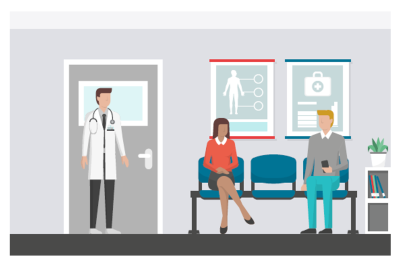 These locks are installed on the door frame and the door, creating a strong magnetic bond when engaged. Their vertical mounting design further enhances security by providing superior holding force, making it difficult for unauthorized individuals to force their way into or out of a patient room or unit. Magnetic bond sensors may be utilized as an option to detect tampering or forced door attempts.
These locks are installed on the door frame and the door, creating a strong magnetic bond when engaged. Their vertical mounting design further enhances security by providing superior holding force, making it difficult for unauthorized individuals to force their way into or out of a patient room or unit. Magnetic bond sensors may be utilized as an option to detect tampering or forced door attempts.
Emergency push buttons, such as panic buttons, also play a vital role in facilitating a swift response to emerging situations within psychiatric units. These buttons are strategically installed in easily accessible locations, enabling staff to quickly activate them in case of an emergency or crisis. Once activated, panic buttons can trigger immediate responses from security personnel or medical staff, allowing for rapid intervention and de-escalation of potentially dangerous situations. The use of these devices empowers healthcare providers and provides peace of mind to patients and their loved ones.
Nurse Stations
A nurse station is a designated area within a medical facility where healthcare personnel perform various administrative tasks, monitor patient care, and provide patient intake. 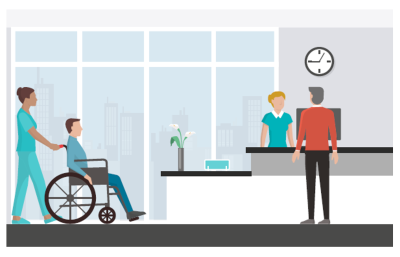 Serving as the central hub for patient, staff, and visitor facing tasks, the access control functions performed in these locations are critical for maintaining continuous operations.
Serving as the central hub for patient, staff, and visitor facing tasks, the access control functions performed in these locations are critical for maintaining continuous operations.
Nurse stations house valuable patient information in a physical form including signed documents, insurance forms, records, etc. Safeguarding these documents is of utmost importance for healthcare facilities to comply with HIPAA and other regulatory privacy standards. Compact maglocks, or Mini-Mites, offer a reliable access control solution to protect file cabinets and drawers where patient documents are stored. Creating 300 pounds of direct holding force, they provide a reliable method of access control and can be mounted on cabinets with either out-swing or in-swing doors. Mini-Mites effectively limit access to sensitive patient records to authorized personnel only, ensuring facility compliance with strict data protection regulations and maintaining the confidentiality of patient information in a variety of locations.

